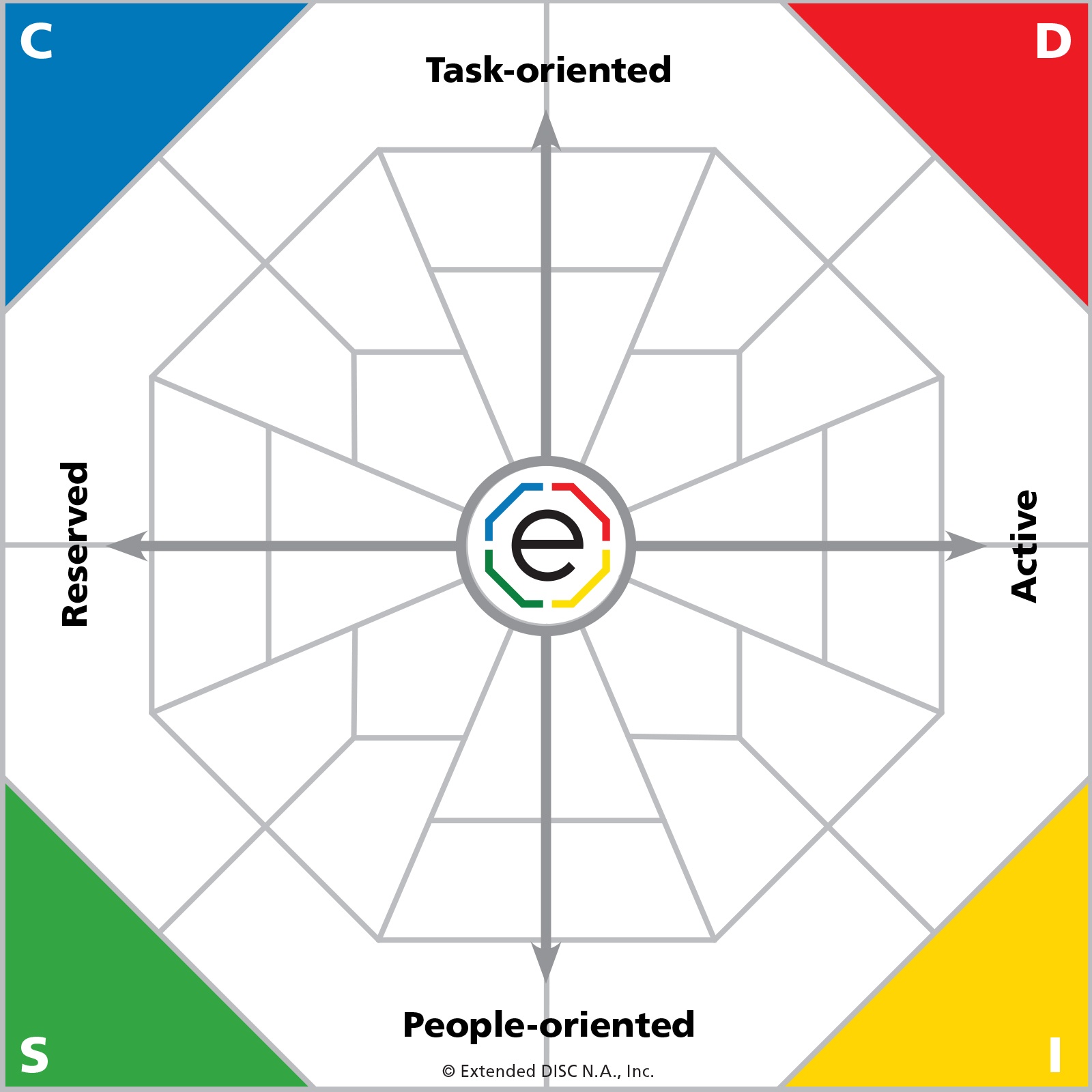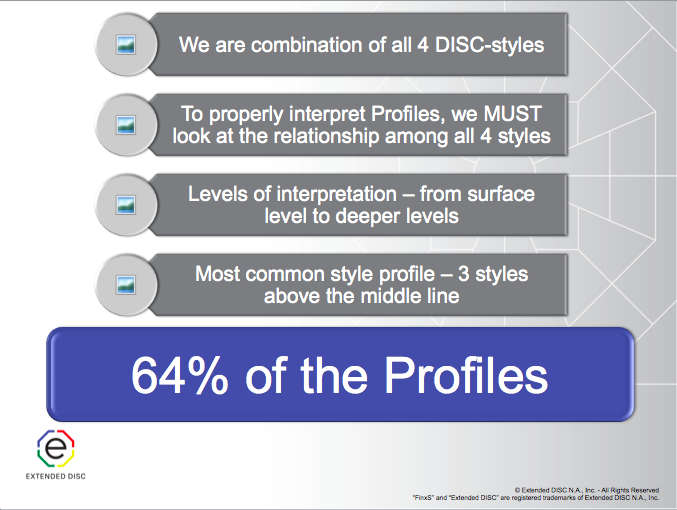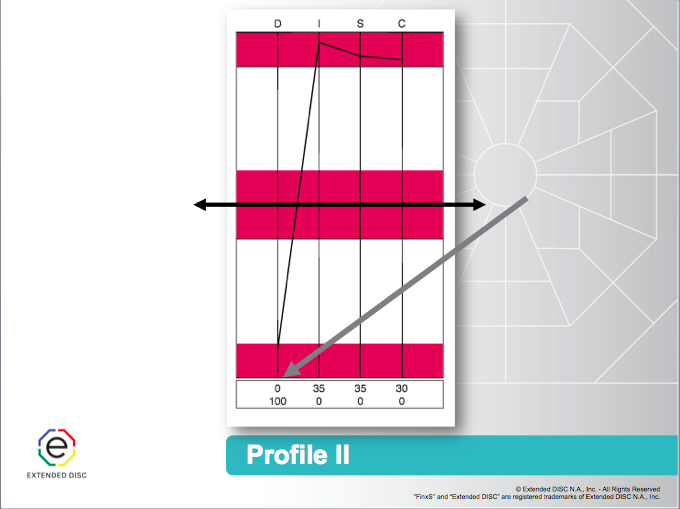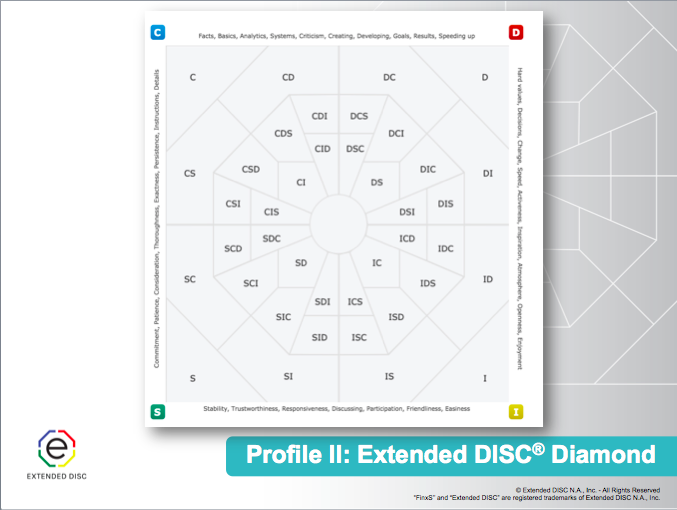Category: DISC Webinars
DISC Profiles: 6 Basic Profile Types
What are the 6 Basic Profile Types?

Ninety nine percent of all individuals who take the Extended DISC Assessment are a combination of DISC styles. The Basic Profile Types describe the 6 DISC profiles that are a combination of two DISC styles. They are the second most common profile type, following profiles with three DISC styles. They are DI/ID, SC/CS, IS/SI, DC/CD, DS/SD and IC/CS. The order of the identification of the basic DISC profiles is not critical.
DISC Profiles: the Opposite Styles
Have you ever heard of Opposite DISC Profiles? The majority of us have not.
DISC Profiles: 3 DISC Styles Above the Line
People’s DISC styles can often be oversimplified by identifying them only by their primary DISC-style.
Are they a D-style, I-style, S-style, or C-style? In reality, when we focus only on one style, we may end up pigeonholing the individual, limiting their successes, and creating misunderstandings. Everyone is a combination of all four DISC styles. Identifying the main DISC styles of others supplies us with important information but, we cannot rely solely on that.
What does 3 DISC styles above the line mean?
 First off, we are speaking directly to the Extended DISC® Profiles. Secondly, if you truly want to understand who the person is, then you need to look at their combination of all 4 DISC styles. Everyone is a combination of the 4 DISC styles; the Extended DISC® Assessment identifies the DISC styles which are natural and the DISC styles which are not natural. Furthermore, the DISC profiles describe the relationship among all 4 DISC styles.
First off, we are speaking directly to the Extended DISC® Profiles. Secondly, if you truly want to understand who the person is, then you need to look at their combination of all 4 DISC styles. Everyone is a combination of the 4 DISC styles; the Extended DISC® Assessment identifies the DISC styles which are natural and the DISC styles which are not natural. Furthermore, the DISC profiles describe the relationship among all 4 DISC styles.
There are different levels of interpretations. For example, we can focus in on their dominant styles, (e.g., DI or CSD), or the DISC styles which are not natural. Let’s focus in on people who have 3 natural styles.
3 Styles above the line Extended DISC® profiles

The most common Extended DISC® profile identifies a person with a combination of 3 DISC styles or 3 styles above the line. In fact, close to two-thirds of all Extended DISC® profiles have 3 styles above the line*; meaning the person has 3 styles that are comfortable and one style that requires a lot of energy.
In the example above, the middle line divides the top half from the bottom half. Your profile will intersect at all 4 DISC axes, but where you intersect above the middle line identifies your natural styles. This person’s profile intersects at the I, S, and C axes which identifies their natural styles as an ISC. The style which is not natural, or takes a lot of energy to exhibit, is the D-style. It doesn’t mean this person can’t be a D-style when they need to, but it requires effort and energy.
Why understanding DISC styles beyond the dominant style is important
 Let’s just say you have an employee or a prospect that you know has 3 styles above the line. Their dominant style is the style that is most comfortable to them, but often times they have additional styles that impact their behaviors and they are also comfortable with. You may find it challenging to figure out how to adjust to their behavioral preferences.
Let’s just say you have an employee or a prospect that you know has 3 styles above the line. Their dominant style is the style that is most comfortable to them, but often times they have additional styles that impact their behaviors and they are also comfortable with. You may find it challenging to figure out how to adjust to their behavioral preferences.
What do you do? You can look to the one style that they are not comfortable with. If you look at the profile sample above, identifying D-style as the person’s least comfortable style, then you can focus on avoiding the D-style behaviors. You will likely find it simpler than trying to adjust to the 3 styles that are comfortable for the person.
If you have one DISC style that takes a lot of energy for you, then you need to be aware and mentally prepared for situations where you need to focus on that particular style.
Understanding the Extended DISC® Diamond

The Extended DISC® Diamond Model is a map; where you are graphed on it identifies your DISC style. If you are graphed in any of the 4 corners of the Diamond, you have one DISC style you are comfortable with, or you have one style above the middle line on the Profiles. People with one DISC style are very rare; they only account for 1% of the global population*.
If you are graphed in the outer ring of the Diamond, you have two DISC styles you are comfortable with, or have two styles above the middle line. People with two DISC styles will account for 31% of the global population*. People who have 3 DISC styles, located in the inner ring of the Diamond, will account for 64% of the global population*.
Focus on who they are not
 From this data, you can see why so many of us have a wider range of behaviors that are comfortable to us. The standard steps to help identify the styles of others is to first observe their patterns of behavior. Next, is to determine if they are more Reserved or Active, and if they are more People or Task oriented. Now you are able to identify their main DISC styles.
From this data, you can see why so many of us have a wider range of behaviors that are comfortable to us. The standard steps to help identify the styles of others is to first observe their patterns of behavior. Next, is to determine if they are more Reserved or Active, and if they are more People or Task oriented. Now you are able to identify their main DISC styles.
However, when you encounter a person who seems to be comfortable with many behaviors, try focusing on who they are not. For example, they are not task oriented or they are not reserved. In recognizing their least comfortable style, you may find it more effective to stay away from those behaviors.
Lastly, do not identify their style too quickly, especially when you need to continue gathering more information about the person. The process never ends. You should continue to look for patterns of behavior so you can further refine your identification of their style and make better adjustments.
*The 2017 Extended DISC® Validation Study
Using the Work Pair to Better Connect With Your Team Members
Managers use the Work Pair Assessment to better connect with their individual team members.
Continue reading “Using the Work Pair to Better Connect With Your Team Members”
How to Successfully Launch DISC Assessments
Tools come and go; in fact, many of them don’t seem to have sustaining power. How can we, as DISC facilitators, create the value required to help people modify behaviors?
Continue reading “How to Successfully Launch DISC Assessments”
What Makes Extended DISC Different from DISC?
Chances are you’ve been asked, “What makes Extended DISC different from other DISC tools?” They are not all the same.
The distinction between the assessments is critical to getting the right information to actually improve communication skills. As trainers we get asked this question all the time. No one owns DISC or the theory, it’s in the public domain. However, there are companies that have their proprietary tools based on DISC. This distinction is important to delivering DISC to your clients and employees, as well as those who are considering upgrading to Extended DISC.
There is a difference!
Extended DISC and other DISC tools do not always measure the same thing. Our tool measures a person’s natural style or what is your most natural way to doing things.
Some tools only measure a person’s adjusted style. The adjusted style focuses on what an individual feels he or she needs to be in their current environment. By focusing on your natural DISC style; not just the style you think you need to be, allows more successful adjustments. One client said “DISC measures who shows up on the first date and Extended DISC who you are in a relationship 5 years later.”
Popularity and criticism of DISC
The simplicity of DISC is one of the major strengths of the tool. It’s easy to learn, understand and use with practice. It becomes a common language that people can communicate with. We use DISC to help individuals make clear decisions on how to modify their behavior to be more successful.
Some people find the model too simple. DISC is fun, but too general or doesn’t provide enough depth beyond a training activity. The results keep changing on some DISC tools so it’s hard to identify a starting point in the person’s development. The results may even be skewed and critical decisions can be made based on inaccurate results.
Measuring who the person is
Unconscious behavior describes the most natural style for a person to behave. It requires little or no energy, is less stressful and allows to person to behave most effectively for longer periods of time. Developing a tool to measure unconscious behavior is more challenging than one measuring conscious behavior. About 90% of our clients are former old DISC users who have upgraded their assessments to Extended DISC.
MBTI® is a respected, researched, and powerful tool that excels at self-discovery. However, it can be difficult to remember the four letter combinations. In addition, clients have noted it can be challenging to use in identifying the styles of others. When a tool is complicated to remember and use, it’s likely not to be used.
Extended DISC different from the rest
 Our tool provides more “horsepower” to allow users to go wider and deeper in application. We focus on a person’s natural style or “hard-wired style.” You are able to identify who you truly are and put into practice the user-friendliness of the DISC model.
Our tool provides more “horsepower” to allow users to go wider and deeper in application. We focus on a person’s natural style or “hard-wired style.” You are able to identify who you truly are and put into practice the user-friendliness of the DISC model.
Other DISC tools have traditionally focused on conscious behaviors. This is what makes Extended DISC different. Ultimately, this creates a tool that is the simple and practical for the business setting, but also has the power of tools like MBTI®.
Can you trust the results of your DISC tool?
Validity is important when it comes to using behavioral assessments. Tools that force results cannot be accurate. Guessing or random choices is deceiving and not useful in making behavioral changes. An invalid result on our tool indicates an inconsistent identification of a DISC style. It is not necessarily a bad result, but it is prevents the respondent from make important decisions based on the wrong information. Another strength of our tool is that it is extensively and continually validated worldwide.
Additional benefits
Clients love the ability to customize reports. Tailored reports provide our associates with the most relevant, assessment for their clients and employees. Our clients are able to offer assessments that are specific to roles like Sales Manager, Bank Tellers, and Executive Leadership. Another reports benefit is the ability to create Work Pair and Team Assessments without having to ask employees to complete an additional questionnaire.
You can manage your assessments online and view DISC results to support organizational analyses and development. There is no additional fee. We provide technical support, an online client resource center, support materials, and access to DISC coaches.  We have endless pricing options that are tailored to your business.
Do you trust your current DISC tool or do you need a tool that is frequently validated, measures true hard-wired DISC style, provides the best support in the industry, and delivers results?
Using DISC to Become a Better Negotiator
We learn specific techniques in order to negotiate better, but we can also be more effective by modifying our behavioral style. Understanding DISC improves our negotiation style.
Using Extended DISC to Improve Customer Service
Many companies fail to deliver excellent customer service and end up losing customers to competitors. How can Extended DISC tools help?
Continue reading “Using Extended DISC to Improve Customer Service”